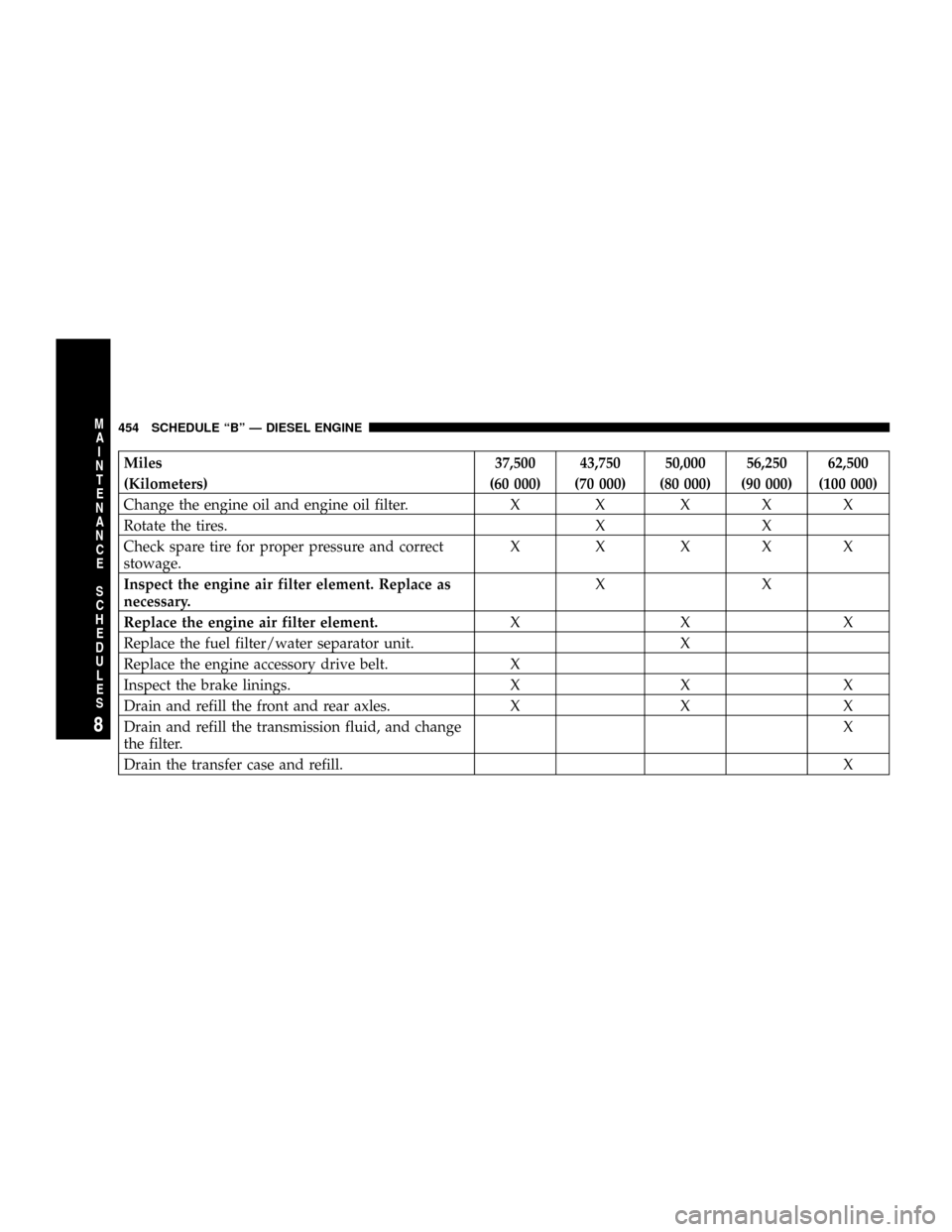2008 JEEP GRAND CHEROKEE transmission oil
[x] Cancel search: transmission oilPage 199 of 490

²HOOD/GATE/DOOR OPEN (with graphic)
²HOOD/GATE/DOORS OPEN (with graphic)
²LIFTGLASS/DOOR OPEN (with graphic)
²LIFTGLASS/DOORS OPEN (with graphic)
²LIFTGLASS/HOOD OPEN (with graphic)
²WASHER FLUID LOW (with graphic)
²COOLANT LOW (with graphic)
²OIL CHANGE REQUIRED
²OIL CHANGE RESET
²CHECK GAUGES
²AUTO HIGH BEAMS ON
²AUTO HIGH BEAMS OFF
²PARK ASSIST DISABLED
²SERVICE SUSPENSION
²SERVICE PARK ASSIST SYSTEM
²TRANSMISSION OVER TEMP
²CHECK SHIFT PROCEDURE
²SERVICE 4WD SYSTEM
²4WD SYSTEM IN NEUTRAL
²LOW BRAKE FLUID LEVEL
²WARNING! LIMIT SPEED
²CHECK GASCAP
²ESP OFF
²IOD FUSE OUT
²HILL DESCENT CONTROL
²MEMORY #1 POSITIONS SET
UNDERSTANDING YOUR INSTRUMENT PANEL 199
4
Page 268 of 490

Operating Tips
Window Fogging
Windows will fog on the inside when the humidity inside
the vehicle is high. This often occurs in mild or cool
temperatures when it's rainy or humid. In most cases
turning on the Air-conditioning (pressing the snowflake
button) will clear the fog. Adjust the temperature control,
air direction and blower speed to maintain comfort.
As the temperature gets colder it may be necessary to
direct air onto the windshield. Adjust the temperature
control and blower speed to maintain comfort. Higher
blower speeds will reduce fogging. Interior fogging on
the windshield can be quickly removed by selecting the
defrost mode.
Regular cleaning of the inside of the windows with a
non-filming cleaning solution (vinegar and water works
very well) will help prevent contaminates (cigarettesmoke, perfumes, etc.) from sticking to the windows.
Contaminates increase the rate of window fogging.Summer Operation
Air conditioned vehicles must be protected with a high
quality antifreeze coolant during summer to provide
proper corrosion protection and to raise the boiling point
of the coolant for protection against overheating. A 50 %
concentration is recommended. Refer to Recommended
Fluids and Genuine Parts for the proper coolant type.
When using the air conditioner in extremely heavy traffic
in hot weather especially when towing a trailer, addi-
tional engine cooling may be required. If this situation is
encountered, operate the transmission in a lower gear to
increase engine RPM, coolant flow and fan speed. When
stopped in heavy traffic, it may be necessary to shift into
N (Neutral) and depress the accelerator slightly for fast
idle operation to increase coolant flow and fan speed.
268 UNDERSTANDING YOUR INSTRUMENT PANEL
Page 301 of 490

and/or the flow rate is reduced. If you must cross
flowing water avoid depths in excess of 9 inches. The
flowing water can erode the streambed causing your
vehicle to sink into deeper water. Determine exit point(s)
that are downstream of your entry point to allow for
drifting.
Standing Water
Avoid driving in standing water deeper than 20 inches,
and reduce speed appropriately to minimize wave ef-
fects. Maximum speed in 20 inches of water is less than 5
mph (8 km/h).
Maintenance
After driving through deep water, inspect your vehicle
fluids and lubricants (engine oil, transmission oil, axle,
transfer case) to assure the fluids have not been contami-
nated. Contaminated fluid (milky, foamy in appearance)
should be flushed/changed as soon as possible to pre-
vent component damage.Driving In Snow, Mud and Sand
In heavy snow, when pulling a load, or for additional
control at slower speeds, shift the transmission to a low
gear and shift the transfer case to 4WD LOW if necessary.
Refer to ªFour-Wheel Drive Operationº in this section.
Do not shift to a lower gear than necessary to maintain
forward motion. Over-revving the engine can spin the
wheels and traction will be lost.
Avoid abrupt downshifts on icy or slippery roads, be-
cause engine braking may cause skidding and loss of
control.
Hill Climbing
NOTE:Before attempting to climb a hill, determine the
conditions at the crest and/or on the other side.
Before climbing a steep hill,shift the transmission to a
lower gear and shift the transfer case to 4WD LOW. Use
first gear and 4WD LOW for very steep hills.
STARTING AND OPERATING 301
5
Page 419 of 490

Fluid Level Check (4.7L and 5.7L Engine)
Check the fluid level while the transmission is at normal
operating temperature. This occurs after at least 15 miles
(25 km) of driving. At normal operating temperature the
fluid cannot be held comfortably between the fingertips.
To check the automatic transmission fluid level properly,
the following procedure must be used:
1. Operate the engine at idle speed and normal operating
temperature.
2. The vehicle must be on level ground.
3. Fully apply the parking brake and press the brake
pedal.
4. Place the gear selector momentarily in each gear
position ending with the lever in P (Park).
5. Remove the dipstick, wipe it clean and reinsert it until
seated.6. Remove the dipstick again and note the fluid level on
both sides. The fluid level should be between the ªHOTº
(upper) reference holes on the dipstick at normal operat-
ing temperature. The fluid level is only valid if there is a
solid coating of oil is seen on both sides of the dipstick. If
the fluid is low, add as required into the dipstick tube.Do
not overfill.After adding any quantity of oil through the
oil fill tube, wait a minimum of two (2) minutes for the oil
to fully drain into the transmission before rechecking the
fluid level.
NOTE:If it is necessary to check the transmissionbelow
the operating temperature, the fluid level should be
between the two ªCOLDº (lower) holes on the dipstick
with the fluid at approximately 70ÉF (21ÉC) (room tem-
perature). If the fluid level is correctly established at
room temperature, it should be between the ªHOTº
(upper) reference holes when the transmission reaches
180ÉF (82ÉC). Remember it is best to check the level at the
normal operating temperature.
MAINTAINING YOUR VEHICLE 419
7
Page 445 of 490

²Change your engine oil more often if you drive your
vehicle off-road for an extended period of time.
²Under no circumstances should oil change intervals
exceed 6,000 miles (10,000 km) or 6 months, whichever
comes first.
Your dealer will reset the oil change indicator message
after completing the scheduled oil change. If this sched-
uled oil change is performed by someone other than your
dealer the message can be reset by referring to the steps
described under ªOil Change Requiredº in ªUse Factory
Settingsº of the EVIC section in this manual.
At Each Stop for Fuel
²Check the engine oil level about 5 minutes after a fully
warmed engine is shut off. Checking the oil level while
the vehicle is on level ground will improve the accu-
racy of the oil level reading. Add oil only when the
level is at or below the ADD or MIN mark.
²Check the windshield washer solvent and add if
required.
Once a Month
²Check tire pressure and look for unusual wear or
damage.
²Inspect the battery and clean and tighten the terminals
as required.
²Check the fluid levels of coolant reservoir, brake
master cylinder, power steering and transmission and
add as needed.
²Check all lights and other electrical items for correct
operation.
MAINTENANCE SCHEDULES 445
8
M
A
I
N
T
E
N
A
N
C
E
S
C
H
E
D
U
L
E
S
Page 454 of 490

Miles 37,500 43,750 50,000 56,250 62,500
(Kilometers) (60 000) (70 000) (80 000) (90 000) (100 000)
Change the engine oil and engine oil filter. X X X X X
Rotate the tires. X X
Check spare tire for proper pressure and correct
stowage.X X XXX
Inspect the engine air filter element. Replace as
necessary.XX
Replace the engine air filter element.XXX
Replace the fuel filter/water separator unit. X
Replace the engine accessory drive belt. X
Inspect the brake linings. X X X
Drain and refill the front and rear axles. X X X
Drain and refill the transmission fluid, and change
the filter.X
Drain the transfer case and refill.X
454 SCHEDULE ªBº Ð DIESEL ENGINE
8
M
A
I
N
T
E
N
A
N
C
E
S
C
H
E
D
U
L
E
S
Page 473 of 490

Drain, Flush, and Refill.................. 408
Inspection........................... 407
Points to Remember.................... 411
Pressure Cap......................... 409
Radiator Cap......................... 409
Selection of Coolant (Antifreeze).........408,440
Crankcase Emission Control System.......... 400
Cruise Light........................... 194
Cup Holder............................ 171
Customer Assistance..................... 460
Data Recorder, Event...................... 56
Daytime Running Lights................... 127
Dealer Service.......................... 393
Defroster, Rear Window................... 178
Defroster, Windshield................70,259,266
Diagnostic System, Onboard................ 390
Diesel Engine Maintenance................. 449
Diesel Fuel............................ 344Diesel Fuel Requirements.................. 344
Digital Video Disc (DVD) Player............. 241
Dimmer Switch, Headlight................. 128
Dipsticks
Automatic Transmission................. 419
Oil (Engine).......................... 394
Power Steering........................ 403
Disabled Vehicle Towing................... 382
Disposal
Engine Oil........................... 397
Used Engine Fluids..................... 397
Door Locks............................. 28
Door Locks, Automatic.................... 29
Door Opener, Garage..................... 158
Drive Belts............................ 398
Driving............................... 299
Off-Pavement......................... 300
Off-Road............................ 300
DVD Player (Video Entertainment System)...... 254
INDEX 473
10
Page 475 of 490

Oil Selection.......................395,440
Oil Synthetic......................... 397
Overheating.......................... 371
Starting............................. 275
Temperature Gauge..................... 192
Engine Oil Viscosity...................... 396
Engine Oil Viscosity Chart................. 396
Enhanced Accident Response Feature.......... 54
Entry System, Illuminated.................. 21
Event Data Recorder...................... 56
Exhaust Gas Caution................69,340,407
Exhaust System......................... 406
Exterior Finish Care...................... 422
Fabric Care............................ 423
Filters
Air Cleaner.......................... 398
Engine Oil........................... 397
Engine Oil Disposal.................... 397Finish Care............................ 422
Flashers.............................. 370
Hazard Warning....................... 370
Turn Signal.....................188,437,438
Flexible Fuel Vehicles
Cruising Range........................ 343
Engine Oil........................... 343
Fuel Requirements..................340,342
Replacement Parts..................... 343
Starting............................. 343
Flipper Glass, Liftgate..................... 35
Flooded Engine Starting................... 277
Fluid Capacities......................... 440
Fluid Leaks............................. 70
Fluid Level Checks
Automatic Transmission............417,418,419
Brake............................... 414
Engine Oil........................... 394
Power Steering........................ 403
INDEX 475
10